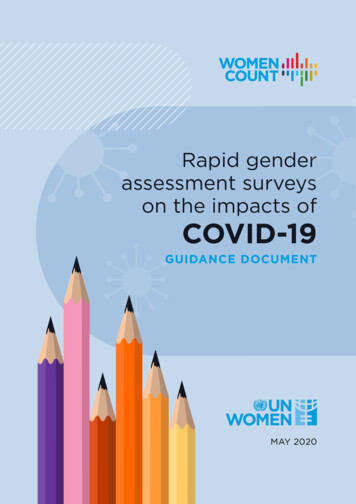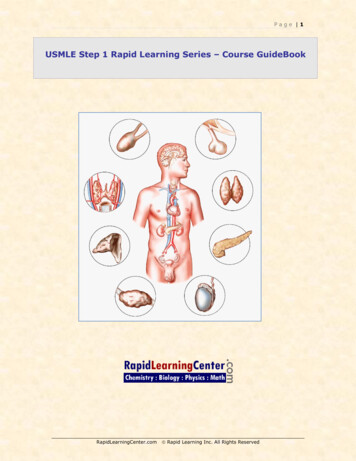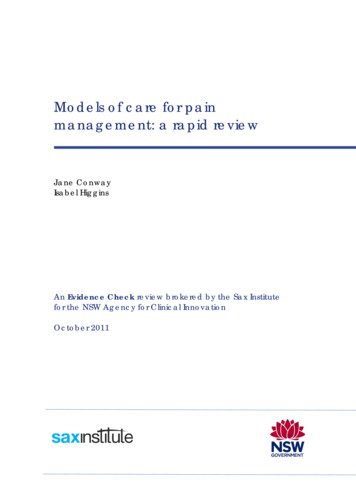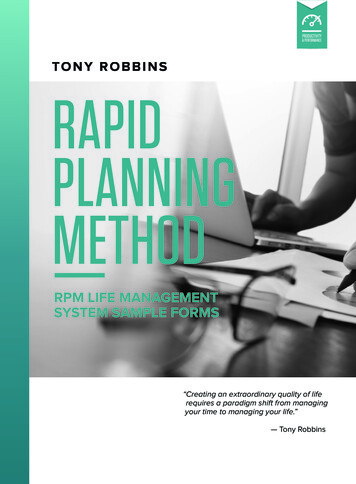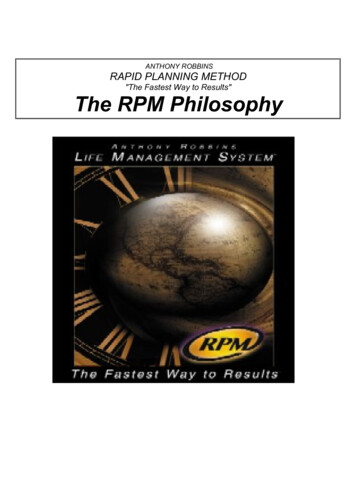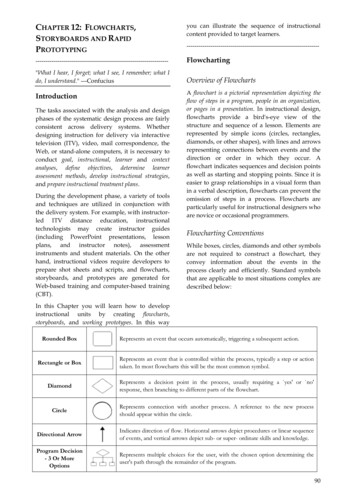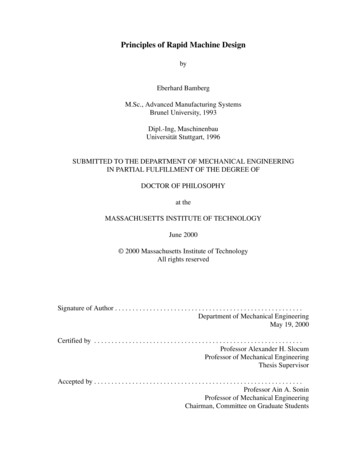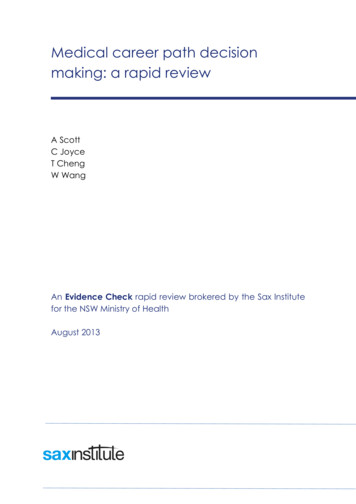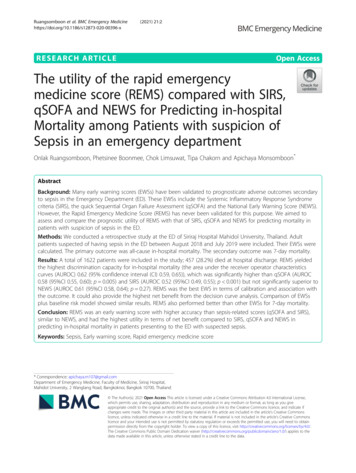
Transcription
Ruangsomboon et al. BMC Emergency (2021) 21:2RESEARCH ARTICLEOpen AccessThe utility of the rapid emergencymedicine score (REMS) compared with SIRS,qSOFA and NEWS for Predicting in-hospitalMortality among Patients with suspicion ofSepsis in an emergency departmentOnlak Ruangsomboon, Phetsinee Boonmee, Chok Limsuwat, Tipa Chakorn and Apichaya Monsomboon*AbstractBackground: Many early warning scores (EWSs) have been validated to prognosticate adverse outcomes secondaryto sepsis in the Emergency Department (ED). These EWSs include the Systemic Inflammatory Response Syndromecriteria (SIRS), the quick Sequential Organ Failure Assessment (qSOFA) and the National Early Warning Score (NEWS).However, the Rapid Emergency Medicine Score (REMS) has never been validated for this purpose. We aimed toassess and compare the prognostic utility of REMS with that of SIRS, qSOFA and NEWS for predicting mortality inpatients with suspicion of sepsis in the ED.Methods: We conducted a retrospective study at the ED of Siriraj Hospital Mahidol University, Thailand. Adultpatients suspected of having sepsis in the ED between August 2018 and July 2019 were included. Their EWSs werecalculated. The primary outcome was all-cause in-hospital mortality. The secondary outcome was 7-day mortality.Results: A total of 1622 patients were included in the study; 457 (28.2%) died at hospital discharge. REMS yieldedthe highest discrimination capacity for in-hospital mortality (the area under the receiver operator characteristicscurves (AUROC) 0.62 (95% confidence interval (CI) 0.59, 0.65)), which was significantly higher than qSOFA (AUROC0.58 (95%CI 0.55, 0.60); p 0.005) and SIRS (AUROC 0.52 (95%CI 0.49, 0.55); p 0.001) but not significantly superior toNEWS (AUROC 0.61 (95%CI 0.58, 0.64); p 0.27). REMS was the best EWS in terms of calibration and association withthe outcome. It could also provide the highest net benefit from the decision curve analysis. Comparison of EWSsplus baseline risk model showed similar results. REMS also performed better than other EWSs for 7-day mortality.Conclusion: REMS was an early warning score with higher accuracy than sepsis-related scores (qSOFA and SIRS),similar to NEWS, and had the highest utility in terms of net benefit compared to SIRS, qSOFA and NEWS inpredicting in-hospital mortality in patients presenting to the ED with suspected sepsis.Keywords: Sepsis, Early warning score, Rapid emergency medicine score* Correspondence: apichaya.m107@gmail.comDepartment of Emergency Medicine, Faculty of Medicine, Siriraj Hospital,Mahidol University, 2 Wanglang Road, Bangkoknoi, Bangkok 10700, Thailand The Author(s). 2021 Open Access This article is licensed under a Creative Commons Attribution 4.0 International License,which permits use, sharing, adaptation, distribution and reproduction in any medium or format, as long as you giveappropriate credit to the original author(s) and the source, provide a link to the Creative Commons licence, and indicate ifchanges were made. The images or other third party material in this article are included in the article's Creative Commonslicence, unless indicated otherwise in a credit line to the material. If material is not included in the article's Creative Commonslicence and your intended use is not permitted by statutory regulation or exceeds the permitted use, you will need to obtainpermission directly from the copyright holder. To view a copy of this licence, visit http://creativecommons.org/licenses/by/4.0/.The Creative Commons Public Domain Dedication waiver ) applies to thedata made available in this article, unless otherwise stated in a credit line to the data.
Ruangsomboon et al. BMC Emergency Medicine(2021) 21:2IntroductionSepsis is a state of organ dysfunction caused by dysregulated host response to infection [1, 2]. It is a critical condition with a high mortality rate and is considered amajor health problem worldwide [1–3]. In high-incomecountries, around 20 million people suffer from sepsiseach year with mortality rate ranging between 17 and26% [4]. In the middle-income country of Thailand, themortality rate was estimated at 25–50% [5, 6]. Thailandhas limited universal coverage health care resources withincreasing emergency department (ED) overcrowding.Thus, the burden of disease is higher than in highincome countries.Early recognition of patients with sepsis is the key toimprove its management, especially in those with greaterseverity who are at risk of adverse outcomes. Developingearly warning score (EWS) tools to identify these patients early may aid clinicians to accelerate treatmentand could lead to improved outcomes. Sepsis was previously defined and identified using Systemic Inflammatory Response Syndrome criteria (SIRS). However, SIRShas been criticized for its low specificity [7–9], which ledto the introduction of the quick Sequential Organ Failure Assessment (qSOFA) proposed by the third international consensus definition (Sepsis-3) [10]. qSOFA hasbeen shown to have better specificity but lower sensitivity than SIRS. Consequently, it might not detect patientsearly enough in their course of disease and may not bebeneficial for ED utilization [11–14].Many EWSs have been developed for ED use. The National Early Warning Score (NEWS) was developed toassess and monitor hospitalized patients for early detection of clinical deterioration [15]. Despite being developed for clinical deterioration, it has been validated as afeasible predictor for adverse outcomes due to sepsis.NEWS has higher accuracy than qSOFA and SIRS forpredicting mortality and intensive care unit (ICU) transfer of suspected septic patients [16–19]. The RapidEmergency Medicine Score (REMS) was developed topredict in-hospital mortality in non-surgical ED patients[20]. It has not been validated and compared to sepsisrelated scoring systems and other EWSs to predict adverse outcomes due to sepsis. Thus, we aimed to validateand compare the clinical utility of REMS, SIRS, qSOFA,and NEWS in predicting in-hospital mortality and mortality within 7 days of admission in ED patients with suspected sepsis.MethodsPage 2 of 13level 1–2 ED visits per year. Siriraj Institutional ReviewBoard approved the study. Patients’ inform consent waswaived due to de-identification of their data.PatientsAdult patients aged 18 years were eligible if they weresuspected of having sepsis by ED physicians using clinical judgement and had hemoculture taken, followed byprescribed intravenous antibiotics or vice versa. Patientstransferred from outpatient units after having beentreated with intravenous antibiotics were excluded.Data collectionWe assessed ED patients retrospectively for eligibility between 1 August 2018 and 31 July 2019. Triage nursesassessed patients visiting the ED and recorded their initial vital signs in the standing triage form, and then attending ED physicians assessed them.We extracted physiologic variables, underlying conditions, management, and outcomes from electronic medical records. All components of each risk score were inthe standing ED admission triage form, from which weused the initial values at presentation to retrospectivelycalculate all risk score values. If sepsis was suspectedafter 4 h from time of ED visit, we imputed the valuesclosest to the time of suspicion, defined as time of culture or antibiotics, whichever came first. We calculatedall risk scores using online calculator (MdCalc onlinecalculator).Scoring systemsSIRS is a 4-item score consisting of pulse rate, respiratoryrate, body temperature and white blood cell counts; eachitem containing 1 point (0–4 points). qSOFA has 3 itemswith 1 point each; respiratory rate, mental status and systolic blood pressure (0–3 points). NEWS and REMS arescoring systems with multiple components with weightedscore points. NEWS (0–20 points) consists of pulse rate,respiratory rate, body temperature, systolic blood pressure,oxygen saturation and need for oxygen supplement.REMS comprises of pulse rate, respiratory rate, mean arterial pressure, mental status, pulse oximetry and age (0–26 points). The components and details of each risk scoreare presented in the Table S1.OutcomesThe primary outcome was all-cause in-hospital mortality, and the secondary outcome was all-cause mortalitywithin 7 days of ED visit.Study design and settingWe conducted a retrospective study at the ED of SirirajHospital, Mahidol University, Bangkok, Thailand. SirirajHospital is the largest tertiary university hospital inThailand with over 20,000 Emergency Severity IndexStatistical analysisWe reported categorical variables as frequency (percentage) and continuous variables as mean (SD) or median(interquartile range) as appropriate. We compared
Ruangsomboon et al. BMC Emergency Medicine(2021) 21:2patient characteristic variables using Chi square, t-test,or Mann-Whitney U test as appropriate.The predictive performance of SIRS, qSOFA, NEWS,and REMS for primary and second outcomes wasassessed. Discrimination was assessed by area under thecurve of the receiver operator characteristics curves(AUROC). We estimated the 95% confidence interval(CI) of the AUROCs and made comparisons betweenEWSs using a bootstrapped method at 10000 replications. We evaluated calibration with calibration plotsand the Hosmer-Lemeshow test, using a smoothed nonparametric method to fit the calibration curves [21, 22].Overall model performance was tested by scaled Brierscore and Nagelkerke’s R squared. A complementaryanalysis of EWSs was performed incorporating information an ED physician may have at assessment includingage, gender, and Charlson Comorbidity Index. Baselinemortality risk models were fitted for each outcome withage as a restricted cubic spline [21]. The additional predictive contribution of each EWS to the baseline riskmodel was assessed by likelihood ratio test. Comparisonsbetween baseline risk model plus an EWS versus baseline risk model plus a different EWS were assessed bybootstrap test with 10,000 replications. Integrated discrimination improvement assessed whether a baselineplus EWS model had better discrimination than thebaseline model alone by difference in discriminationslopes between the models [23].Good discrimination and calibration may not reflectthe clinical usefulness of an EWS because they assignequal weight to sensitivity, specificity, and prediction errors. ED physicians making decisions in clinical practiceusually assign different weights to these based on the patient’s characteristics and available resources. To reflectthis, we calculated net benefit (NB) at each thresholdprobability from decision curve analysis [24]. For a patient with suspected sepsis, the ED physician weights theharm/cost of overtreatment against the benefit of treatment (the harm/cost-to-benefit ratio). If the physicianthinks that the harm/cost-to-benefit ratio is 1:9, this represents a threshold probability of 10%, and the numberof patient that the physician is willing to treat (NWT) toprevent the mortality outcome is 10. We present athreshold probability range from 1 to 20% (NWT from100 to 5, respectively), which is a plausible range overwhich a physician would use an EWS for a patient withsuspected sepsis. A higher NB is desirable at any threshold probability and should be higher than ‘treat all’ or‘treat none’ strategies to have clinical utility.Clinical usefulness at cutoff values was also assessedby sensitivity, specificity, positive likelihood ratio (LR ),negative likelihood ration (LR-), negative predictive value(NPV) and positive predictive value (PPV). These werecalculated for SIRS and qSOFA at the recommendedPage 3 of 13cutoffs from previous literature [10, 25]. For NEWS andREMS, we reported the accuracy at the optimal cutpoint according to optimal Youden index. Pre-specifiedsubgroup analyses were performed by age 70 years andage 70 years as well as by no comorbidities and at leastone comorbidity. Comorbidities included chronic neurologic disease, acute stroke, chronic respiratory disease,chronic liver disease, neoplasia, chronic renal disease,diabetes mellitus, chronic heart failure, and immunocompromised status.All statistical analyses were performed using R software version 3.6.1 (R Foundation for Statistical Computing, Vienna, Austria) with the rms, Hmisc, foreign,pROC, sciplot, and dca packages except for sensitivityand specificity, LR , LR-, NPV and PPV, which were calculated using MedCalc for Windows version 19 (MedCalc statistical software, Mariakerke, Belgium).ResultsStudy populationA total of 15,830 patients visited the ED during August2018–July 2019. Of these, 1927 (12.2%) patients had suspected sepsis, and 305 were excluded because they hadbeen treated and transferred from other units. Consequently, 1622 patients with suspected sepsis were included in the final analysis. Of these, 457 (28.2%) metthe primary outcome of all-cause in-hospital mortality,and 280 (17.3%) died within 7 days of admission. A totalof 1382 (85.2%) were diagnosed with sepsis at hospitaldisposition according to Sepsis-3 definition. Patientcharacteristics are shown in Table 1. The study population’s mean age SD was 72.6 15.4 years, and 51.1%were female. Patients who had all-cause in-hospital mortality were older, had a greater prevalence of neoplasia,and more history of recent hospital admission. They alsohad significantly more severe abnormal initial vital signs,higher serum white blood cells and band-form cellcounts, as well as higher rate of positive hemoculture,inotropic drug prescription and ICU admission compared with patients discharged alive.Scoring systemsNone of the 1622 patients with suspected sepsis had missing EWS values. All 4 mean score values except SIRS weresignificantly higher in those who died (Table 1). qSOFAand REMS showed clear association with both mortalityoutcomes whereas higher SIRS did not, and all-cause inh
tions, management, and outcomes from electronic med-ical records. All components of each risk score were in the standing ED admission triage form, from which we used the initial values at presentation to retrospectively calculate all risk score values. If sepsis was suspected after 4h from time of ED visit, we imputed the values closest to the time of suspicion, defined as time of cul-ture or .

